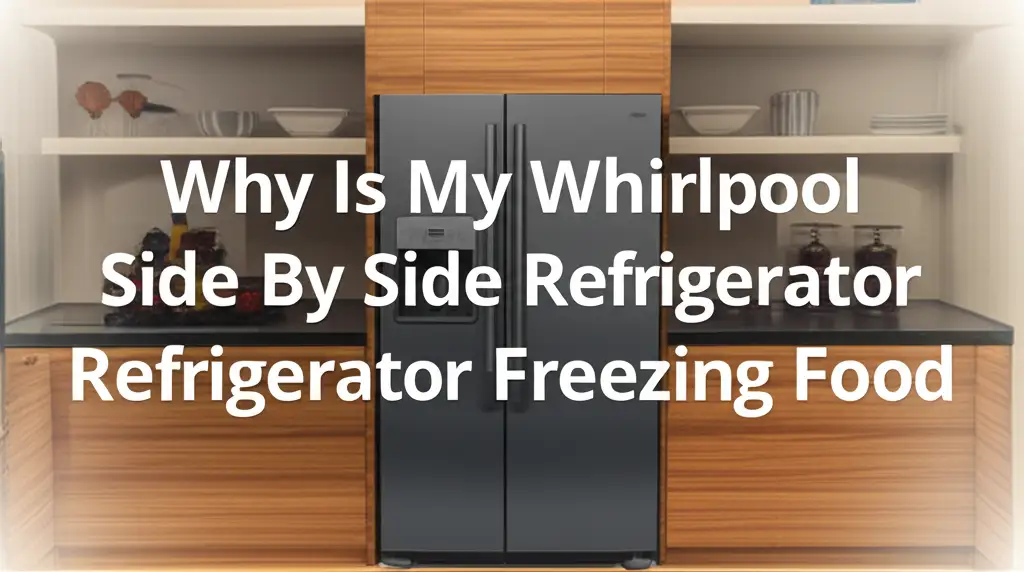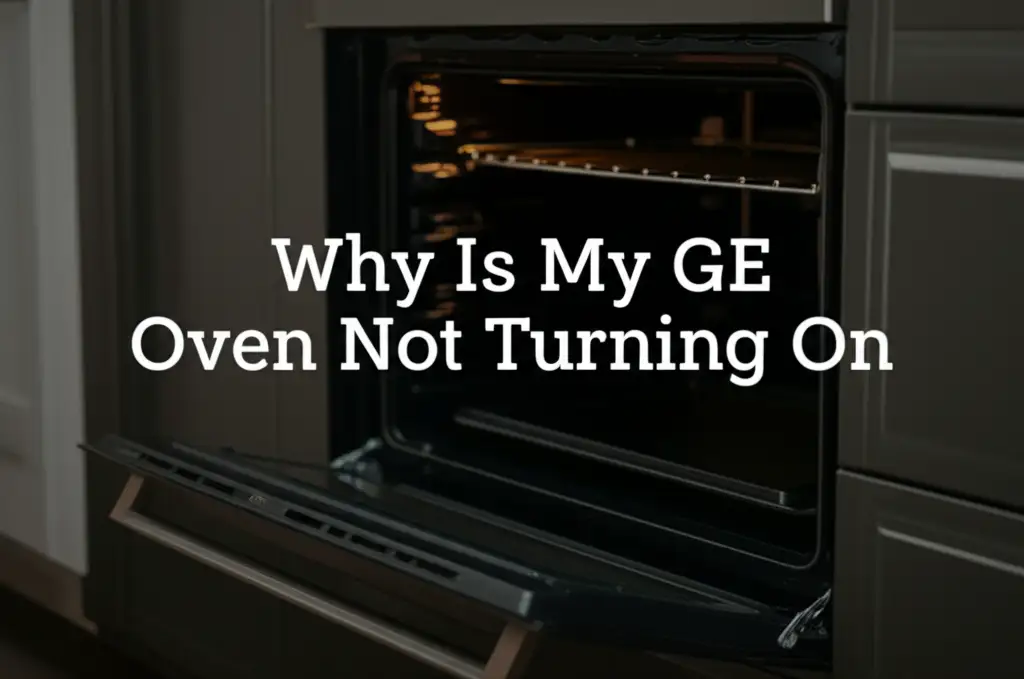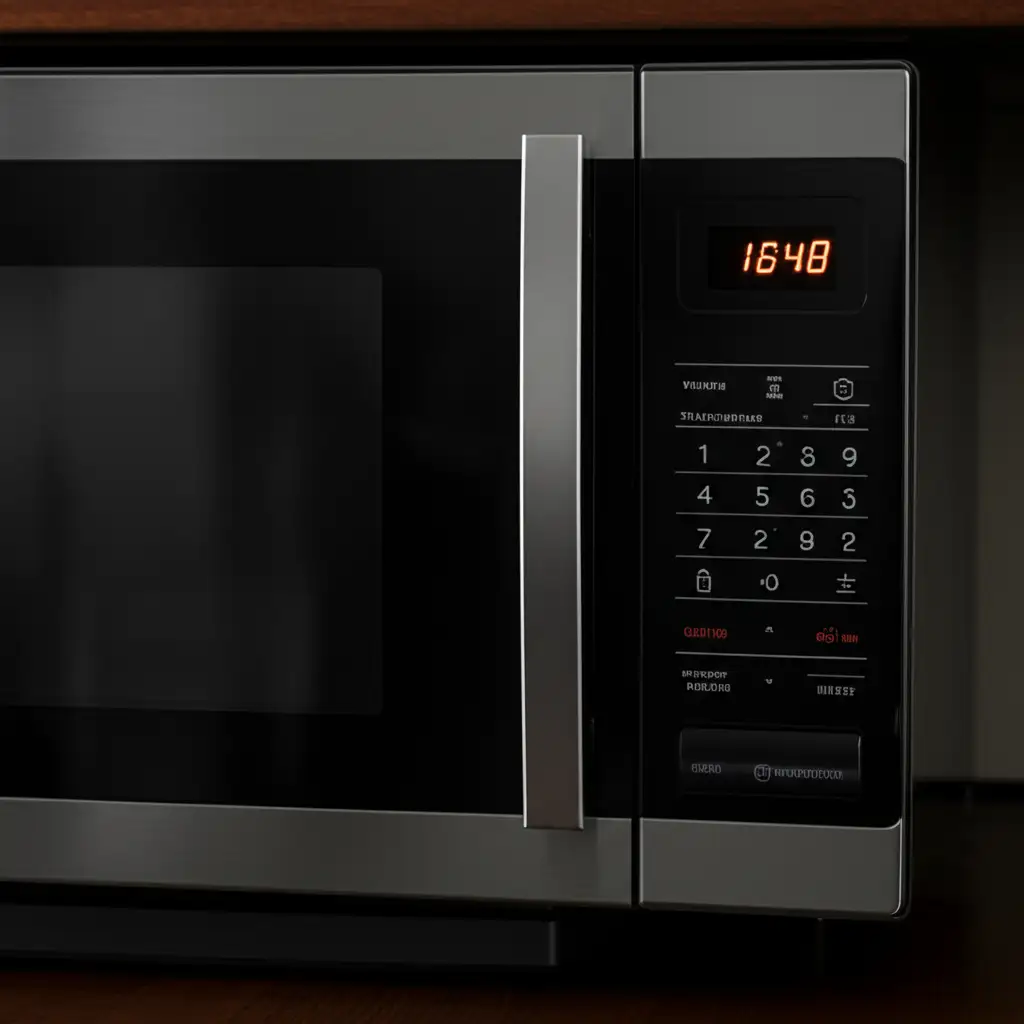· Katria Melrose · Appliance Repair Guides · 16 min read
Why Is My Whirlpool Side By Side Refrigerator Freezing Food

Solving Your Whirlpool Side By Side Freezing Issue
It is frustrating when you open your Whirlpool side by side refrigerator and find food frozen solid. A refrigerator should keep food cool, not turn it into an ice block. This common problem affects many homeowners. It often signals an underlying issue with the appliance’s cooling system or controls. I understand the inconvenience this causes.
In this article, we explore the primary reasons why your Whirlpool side by side refrigerator is freezing food. We will cover common culprits like faulty temperature controls, airflow issues, and component malfunctions. You will find practical steps to diagnose and fix these problems. Our goal is to help you restore your refrigerator to proper working order. You can save your groceries and avoid unnecessary repair costs.
Takeaway
- Check your refrigerator’s temperature settings first; they might be too low.
- Inspect the damper control and thermistor for proper function.
- Ensure clear airflow inside and around the appliance.
- Address any issues with the door gasket or control board.
- Prevent overpacking your refrigerator to allow air circulation.
A Whirlpool side by side refrigerator freezes food primarily due to incorrect temperature settings, a faulty thermistor or damper control, blocked air vents, or a defective main control board. These issues cause the refrigerator compartment to drop below safe refrigeration temperatures, leading to items freezing. Identifying the exact cause requires systematic troubleshooting.
Understanding Your Whirlpool Refrigerator’s Temperature Control
The most direct cause of a Whirlpool side by side refrigerator freezing food is an incorrect temperature setting. Your refrigerator’s internal temperature controls decide how cold the unit gets. If someone accidentally set the temperature too low, your food will inevitably freeze. This simple oversight is often the first thing to check.
The ideal refrigerator temperature sits between 35°F (1.7°C) and 38°F (3.3°C). Any setting below this range increases the risk of freezing. I always recommend checking your appliance manual for the specific recommended settings for your model. Adjusting the temperature is a quick and easy first step in troubleshooting this common problem.
How Thermostats Work
Your Whirlpool refrigerator uses a thermostat or a temperature sensor to monitor its internal conditions. The thermostat acts as the brain of the cooling system. It tells the compressor when to turn on and off. When the refrigerator gets too warm, the thermostat signals the compressor to start cooling. When it reaches the set temperature, the thermostat signals the compressor to stop.
If the thermostat malfunctions, it might send continuous signals to the compressor. This causes the refrigerator to cool more than it should. An old or faulty thermostat can lead to consistently lower temperatures. This results in your food freezing.
Temperature Settings Explained
Whirlpool refrigerators often have digital temperature displays or mechanical dials. Digital displays make it easy to see and adjust the exact temperature. Mechanical dials usually have a range from “coldest” to “warmest” or numbers from 1 to 7. A higher number typically means a colder setting on a dial.
Ensure your settings are not on the absolute coldest option. Sometimes, slight changes in ambient room temperature or even frequent door openings can make people adjust settings unnecessarily. Always aim for the recommended 35-38°F range for optimal food preservation without freezing. Remember, consistency is key for proper food storage.
Damper Control Malfunctions: A Common Culprit
A damper control serves as a critical component in your Whirlpool side by side refrigerator. It controls the flow of cold air from the freezer compartment into the fresh food section. This small, adjustable flap opens and closes to regulate temperature. If the damper control gets stuck open, too much cold air enters the refrigerator. This causes your food to freeze.
The damper is usually located at the back or top of the refrigerator compartment. It works automatically to maintain the set temperature. A malfunctioning damper cannot regulate airflow properly. This leads to temperature imbalances and often, frozen food.
Checking the Damper
You can often inspect the damper control yourself. First, unplug your refrigerator for safety. Locate the damper, which might be behind a panel. Check if anything obstructs its movement. Dust, ice, or even a small food item can jam the flap.
Carefully try to move the flap by hand. It should move freely and without resistance. If it feels stiff or stuck, it might need cleaning or replacement. A broken damper often means it stays fully open. This sends a constant blast of freezing air into the fridge section.
Cleaning and Unblocking Damper
Cleaning a damper control is a simple task. Use a soft cloth and warm, soapy water to wipe away any dust or debris. If ice buildup causes the issue, you may need to perform a manual defrost of your refrigerator. Unplug the unit for several hours. This allows all ice to melt.
After defrosting, clean the area thoroughly. Then, plug the refrigerator back in and observe the damper’s operation. If cleaning does not resolve the issue, the damper motor or mechanism might be faulty. In such cases, you will likely need a replacement part. A properly functioning damper ensures even cooling throughout the refrigerator.
Issues with the Thermistor or Temperature Sensor
Your Whirlpool side by side refrigerator relies on a thermistor, or temperature sensor, to give accurate readings. This tiny component measures the internal temperature of your refrigerator. It sends this information to the main control board. The control board then uses this data to decide when to activate the compressor or fan motors.
If the thermistor is faulty, it might provide inaccurate readings. For example, it could tell the control board that the refrigerator is warmer than it actually is. In response, the control board will command the compressor to run longer. This results in the refrigerator getting too cold and freezing your food. A bad thermistor is a common reason for temperature instability.
Testing Thermistor Resistance
You can test a thermistor’s functionality using a multimeter. First, locate the thermistor inside your refrigerator compartment. It often clips onto the wall or a cooling coil. Disconnect its wires. Set your multimeter to measure resistance (ohms).
Place the multimeter probes onto the thermistor’s terminals. Compare the reading to the specifications in your refrigerator’s service manual. The resistance value changes with temperature. You can test it at room temperature and then by holding it in your hand or placing it in ice water. Significant deviations from the expected range indicate a faulty thermistor.
Sensor Location and Replacement
Whirlpool refrigerators typically have thermistors in various locations. One is usually in the fresh food compartment, another in the freezer, and sometimes near the evaporator coils. Check your appliance manual for the exact locations for your model. Knowing where they are helps with accurate testing and replacement.
Replacing a thermistor is usually a straightforward task. It often involves unplugging the old one and plugging in a new one. Ensure you purchase the correct part number for your specific Whirlpool model. Always disconnect power to the refrigerator before starting any repair work. A new, accurate thermistor helps the refrigerator maintain stable temperatures.
Airflow Problems and Frost Build-up
Proper airflow is vital for your Whirlpool side by side refrigerator to maintain consistent temperatures. Cold air circulates from the freezer into the fresh food compartment and back. Vents facilitate this air movement. If these vents become blocked, whether by food items or frost, the air circulation gets disrupted. This can lead to warm spots in some areas and excessively cold spots, causing food to freeze, in others.
Frost buildup on the evaporator coils or in the air ducts is a frequent cause of airflow restriction. The defrost system manages this. If the defrost heater, defrost thermostat, or defrost timer fails, ice can accumulate. This blocks airflow, making the refrigerator work harder and cool unevenly.
Clearing Vents
Start by checking the vents inside your refrigerator. These are usually small slots or grates. Ensure no food packages or containers are directly blocking them. Rearrange items to allow air to flow freely. Pay attention to vents near the back of the refrigerator compartment, as these are often the intake points for cold air.
You should also check the return air vent, often near the bottom or side. A blocked return vent prevents warmer air from cycling back to the freezer for cooling. Clearing these obstructions ensures your refrigerator can distribute cold air effectively. This simple step can often prevent freezing.
Manual Defrosting
If you suspect frost buildup, a manual defrost can resolve the issue. Unplug your Whirlpool side by side refrigerator from the power outlet. Empty both the freezer and fresh food compartments. Prop open the doors. Place towels on the floor to catch any melting water.
Allow the refrigerator to defrost for several hours, or even overnight. This gives all the ice a chance to melt from the evaporator coils and air ducts. Once defrosted, clean the interior thoroughly. You can find tips on how to clean the refrigerator for best results. Plug the unit back in and monitor its performance. This can often reset the cooling system and prevent immediate re-freezing. If the frost returns quickly, a component in the automatic defrost system likely needs replacement.
Faulty Main Control Board or Defrost Timer
The main control board acts as the central computer of your Whirlpool side by side refrigerator. It receives signals from various sensors and sends commands to all major components. These components include the compressor, fans, and defrost system. If the main control board malfunctions, it can send incorrect signals. For example, it might tell the compressor to run too often or the defrost system to fail. This leads to the refrigerator getting too cold and freezing your food.
Similarly, the defrost timer is crucial for preventing excessive ice buildup on the evaporator coils. It periodically activates the defrost heater to melt frost. A faulty defrost timer can prevent this process. This leads to ice accumulation, blocked airflow, and ultimately, a refrigerator that runs too cold. Both of these components require careful diagnosis.
Identifying Control Board Problems
A main control board issue often presents with multiple symptoms. You might notice inconsistent temperatures, unusual cycling patterns, or non-responsive controls. Sometimes, the refrigerator might run continuously without proper temperature regulation. There are no easy DIY fixes for a faulty control board. It typically requires professional diagnosis and replacement.
Before replacing the control board, ensure you have ruled out simpler issues. Check temperature settings, thermistors, and damper controls first. Control boards are expensive. Replacing one without certainty of its fault is not cost-effective. Sometimes, power surges can damage control boards. If your refrigerator keeps turning on and off erratically, it could be a sign of a control board issue or other electrical problem. Learn more about refrigerators turning on and off.
Defrost Timer Operation
The defrost timer cycles between cooling mode and defrost mode. It usually runs for several hours in cooling mode. Then, it switches to a short defrost cycle. This cycle melts any frost on the evaporator coils. If the defrost timer fails to advance, it will not initiate the defrost cycle. This causes frost to build up excessively.
A continuous cooling cycle can also occur if the timer is stuck in the cooling position. This prevents the heater from turning on. The continuous cold leads to the freezing of food. You can sometimes test a mechanical defrost timer by manually advancing it. Listen for the click that indicates it has switched cycles. If it does not advance or clicks back, it likely needs replacement. Electronic defrost timers are more complex and require professional diagnosis.
Gasket and Door Seal Integrity
The door gaskets, also known as door seals, are vital for maintaining a consistent internal temperature in your Whirlpool side by side refrigerator. These rubber seals create an airtight barrier when the doors close. They prevent warm, humid air from entering the refrigerator compartment. If the gaskets are worn, torn, or improperly sealed, warm air can seep in.
When warm, moist air enters the cold environment, it can cause several problems. The refrigerator’s compressor will run more frequently and for longer periods to counteract the warmer air. This continuous operation can lead to an overall colder temperature in the fresh food section, causing items to freeze. It also increases frost buildup on coils and reduces energy efficiency.
Testing the Door Seal
You can easily test the integrity of your refrigerator’s door seals. Use the “dollar bill test.” Close the refrigerator door on a dollar bill. Try to pull the bill out. If it slides out easily, the seal in that spot is weak. Repeat this test around the entire perimeter of both refrigerator and freezer doors.
Another method involves using a flashlight. Place a flashlight inside the refrigerator and close the door. Turn off the room lights. If you see any light leaking from around the door, it indicates a compromised seal. These tests help pinpoint exact locations of air leaks.
Replacing Worn Gaskets
Replacing worn gaskets is a straightforward repair that can significantly improve your refrigerator’s performance. First, obtain the correct replacement gaskets for your specific Whirlpool side by side model. You can usually find the model number inside the refrigerator or on a sticker at the back.
Carefully pry off the old gasket, which is often held in place by screws or a retaining channel. Clean the area thoroughly. Then, press or screw the new gasket into place. Ensure it fits snugly and creates a tight seal all around the door. After replacement, re-test the seal. A good seal keeps your refrigerator efficient and helps maintain stable temperatures. This prevents unnecessary freezing and helps to keep your refrigerator clean. Learn more about how to clean the refrigerator.
Overpacking and Food Placement Habits
How you store food inside your Whirlpool side by side refrigerator significantly impacts its ability to cool properly. Overpacking the fresh food compartment is a common mistake. When shelves are too full, it blocks the essential airflow needed for even temperature distribution. Cold air needs space to circulate around all your groceries. Without this circulation, some areas of the refrigerator become much colder than others, often leading to food freezing, especially near the air vents.
Improper food placement also plays a role. Placing items directly in front of or against air vents can obstruct the flow of cold air. This creates pockets of intensely cold air right at the source, while other areas may not receive enough cooling. Strategic food placement is key to preventing freezing issues and maintaining consistent temperatures.
Proper Food Storage
Adopt smart habits for organizing your refrigerator. Leave some space between items on shelves. This allows cold air to move freely around your food. Consider using clear containers to organize items. This makes it easier to see what you have and avoids cramming.
Keep dairy products and meats on lower shelves where temperatures are typically most stable. Fruits and vegetables do best in crisper drawers with humidity controls. Avoid placing delicate items like leafy greens or milk too close to the back wall or directly under freezer vents, as these spots tend to be the coldest.
Avoiding Vent Blockage
Locate the air vents inside your refrigerator. They are usually at the back or on the top shelf. Make it a point to never place food items directly in front of or on top of these vents. These vents are crucial for distributing cold air from the freezer into the fresh food section.
If a vent is blocked, the cold air hits the obstruction and stays in that immediate area. This can cause the food around the blocked vent to freeze. Meanwhile, other parts of the refrigerator may not get enough cold air. Regular checks to ensure vents are clear will prevent this common cause of freezing. Good airflow ensures an evenly cooled refrigerator and prevents your food from freezing.
FAQ Section
Can a faulty thermostat cause my Whirlpool fridge to freeze food?
Yes, a faulty thermostat is a common cause. If the thermostat fails to accurately read the refrigerator’s temperature, it might tell the compressor to run continuously. This overcooling leads to the fresh food compartment dropping below freezing temperatures. You can test a thermostat with a multimeter for proper resistance.
How do I check the damper control in my Whirlpool side by side refrigerator?
First, unplug your refrigerator. Locate the damper, usually at the back or top of the fresh food compartment. Visually inspect it for obstructions like ice or food debris. Gently try to move the damper flap. It should move freely. If it is stuck or stiff, it may be faulty or obstructed and needs cleaning or replacement.
Is frost build-up causing my food to freeze in my Whirlpool fridge?
Yes, excessive frost buildup on the evaporator coils or inside air ducts can cause food to freeze. This occurs because the frost blocks proper airflow, making the refrigerator run longer to achieve the set temperature. This leads to parts of the fresh food section becoming too cold. A manual defrost can often resolve this temporarily.
Why is my Whirlpool side by side refrigerator freezing food on the top shelf?
Food freezing on the top shelf often indicates that the air damper, which controls cold air flow from the freezer, is stuck open. This sends a constant blast of freezing air directly into the upper part of the fresh food compartment. Also, ensure no items are blocking the air vents near the top.
What is the ideal temperature setting for a Whirlpool refrigerator?
The ideal temperature setting for your Whirlpool refrigerator’s fresh food compartment is between 35°F (1.7°C) and 38°F (3.3°C). This range keeps food fresh and safe without risking freezing. The freezer compartment should be set to 0°F (-18°C) for optimal food preservation.
How can I fix my Whirlpool refrigerator freezing food?
Start by checking your temperature settings. Then, inspect the damper control for obstructions. Test the thermistor with a multimeter. Ensure all internal air vents are clear and perform a manual defrost if frost buildup is evident. Finally, check door gasket seals. If these steps do not help, consider a faulty main control board.
Conclusion
Finding your food frozen solid in your Whirlpool side by side refrigerator can be quite a shock. I know it can be frustrating to deal with spoiled groceries and unexpected appliance issues. However, understanding the common causes allows you to approach the problem methodically. We have explored several key culprits, from simple temperature setting errors to more complex component failures.
By systematically checking your temperature controls, inspecting the damper and thermistor, and ensuring clear airflow, you can often diagnose the problem. Remember to also consider potential issues with the main control board or door gaskets. Many of these fixes are simple DIY tasks that can save you money and inconvenience. With a little troubleshooting, you can prevent your Whirlpool side by side refrigerator from freezing food. I hope these steps help you get your refrigerator back to optimal performance, keeping your food fresh, not frozen.
If you are unsure or uncomfortable performing any of these repairs, do not hesitate to call a certified appliance technician. They can provide professional diagnosis and service. Regular maintenance, including cleaning under your refrigerator, can also help prevent future issues and extend your appliance’s life. Learn more about how to clean under a refrigerator.
- Whirlpool refrigerator
- freezing food
- side by side fridge
- refrigerator troubleshooting
- appliance repair
- temperature control
- cold food





